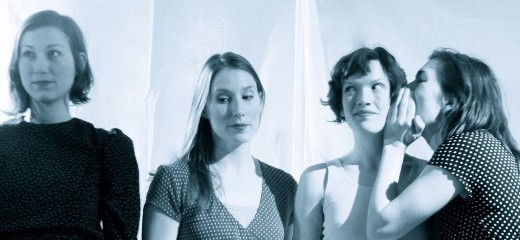
Photo: Joy Davis
iMprovisational Melange at Mascher
by Lisa Bardarson
Experiments in movement improvisation are a tricky business that can yield sublime surprises if one is willing to be patient. My evening at the H.O.T. Series at the Mascher Space Co-op contained some delightful moments and I have chosen to highlight three of the pieces presented in a program that spanned nearly three hours.
The atmosphere of the evening was casual and convivial. There was a cash bar that was open for the duration of the evening and no written programs but multiple announcements instead. This required me to come out from my cover of thINKingDANCE anonymity (a bit uncomfortably) to gather facts like the spelling of names. The informality also gave me a chance to introduce myself and chitchat with some of the performers.
The first piece on the bill featured two artists from New York. Percussionist Michael Evans, who used a flute, an array of metal bowls and industrial objects collaborated with dancer Susan Hefner. Evans began his musical meanderings playing a wooden flute to which Hefner responded with quick, sharp arm gestures while her gaze darted constantly. Taking three graduated metal bowls from Evans’ set up, Hefner banged and moved with them (although I’m not sure why, other than that they were there). Her frenetic relationship with the props was missing organic motivation and her face mugged constantly. With no stillness there was little opportunity to savor her discoveries. Evans accompanied with earnest attentiveness.
An investigation by the Mountain Empire connected four women: Barbara Allie Tait, Rachael Rugh, Eliza Larson and Katie Sopoci Drake. The piece was aptly named The Telephone Project, and if I understand correctly, they structured this dance using a whispering-down-the-lane set of instructions to guide them through this improvisation. There was a pleasing, cohesive quality to this grouping of movement explorers, enhanced by the complementary jewel tones of their practice clothes. All seasoned movers, they found a good groove in some strong duets, while a skittery hand gesture as repeating motif kept the piece and me connected. The dancers shouted out commands: “Do A! C! Retrograde! Faster!” tempering the identified phrases. Witnessing them execute these tasks with relish was like watching Julia Child chop an onion; no muss, no fuss and no tears.
Another duet featured dancers Emile Sorger and Joy Davis with musicians Neil Feather and BMore. It was fun to see the dancers chew through the space in their distinct styles: Sorger rarely moved off of his vertical axis and tended towards homo-lateral, chunky ambulation while Davis moved in luscious three-dimensionality. The interaction of the dancers’ and musicians’ energies was nothing short of delightful. If I was told they’d been working together for years I would have believed it, their connection was that keen. In fact, they met that night. At one point, they raced through the space with such joyful abandon that it took my breath away. When Davis went for the three graduated metal bowls that appeared in the Evans-Hefner collaboration, it was if to say, “Here’s what you can really do with these things.” Davis and Sorger tossed, caught, manipulated and integrated them into their improv with aplomb and authenticity. Somehow, the bowls had been vindicated.
H.O.T. Series of Philadelphia, Mascher Space Cooperative, May 10, 2014
By Lisa Bardarson
May 23, 2014

